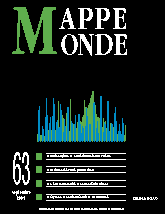
. When Berlin is written in capital letters: a critical view. (5 fig.)
Berlin, a city without a centre, a puzzle and a constantly evolving capital, is suprising to the visitor and interesting to the geographer. Tired of the strange image conveyed by a city that symbolises the turmoil of the 20 th century, the public authorities seem determined to « correct the city » and make it the respected capital of reunified Germany. From a historical perspective, this article takes a critical view of the new Berlin, characterised by monumentalism and uniformity.
keywords: ARCHITECTURE, BERLIN, HISTORY, MAJOR PROJECTS, MEMORY, TOWN-PLANNING
Philippe Moyen. An attempt at modelling the 12 century Mediterranean (2 fig.)
Geographical and practical spatial representations produce a complex image of the Mediterranean in the 12th century, an equivocal place in which each civilisations identity is felt through contact variously war or trade with the others.
keywords: 12th CENTURY, MEDITERRANEAN, SPATIAL PRACTICES
Roger Brunet. France reshaped by its towns (4 fig.)
In the territory of France, a study of net migration and natural increase at canton level between 1990 and 1999 shows that, although some strong structural and cyclical disparities persist, these differences are diminishing and peri-urban areas have spread. The inter-city scale shows a different pattern.
keywords: FRANCE, MIGRATION, POPULATION, TOWN AND COUNTRY, URBANISATION
. The urban landscapes of Cayenne, French Guiana (5 fig.)
Cayenne, the capital of French Guiana, shows forms of urbanization that are atypical for a French Department. The heterogeneous urban landscape of Cayenne is the joint product of a harsh equatorial environment and juxtaposed ethnic groups exhibiting marked socio-economic differences. The consequences of this disorderly urbanization are numerous and akin to those of many Third World cities.
keywords: CAYENNE, URBANIZATION, ETHNIC GROUPS, SPONTANEOUS SETTLEMENT, INSALUBRITY
Fernand Verger. Tides and tourists at the Mont-Saint-Michel (4 fig.)
Although the fast-rising tides in the bay of the Mont-Saint-Michel conjure up strong images in the collective imagination, tourist numbers are only slightly influenced by the phenomenon, despite the existence of a Ð relatively small Ð specific public, attracted by tidal bores.
keywords: MONT-SAINT-MICHEL, TIDAL BORE, TIDE, TOURISM
Fernand Verger. Natural sedimentation and civil engineering near the Mont-Saint-Michel (4 fig.)
For two centuries, civil engineering works near the Mont-Saint-Michel have always resulted in natural sedimentation, jeopardising the areas maritime character. Although awareness of the sites value emerged as early as the Second Empire, works to maintain its maritime characteristics did not begin until 1983, and will only be implemented on a significant scale in the next few years.
keywords: 18th CENTURY MAP, DYKES, MONT-SAINT-MICHEL, NATURAL SEDIMENTATION, POLDERS
. Minais Gerais: a mirror of Brazil. A proposed new atlas (7 fig.)
The production of an electronic atlas of the State of Minas Gerais was decided because of the variety of physical, economic, social and political landscapes there that mirror Brazil as a whole. The atlas is upgradable and will be updated and made available to the public over the Internet. The methodology used combines the most modern instruments of computerised cartography and the methods designed by French geography to identify the structures and organisation of Minas Gerais. The atlas is a valuable tool for the public authorities, private enterprise and researchers.
keywords: COMPUTERISED CARTOGRAPHY, GIS, MANAGEMENT, TERRITORY
. The spatial distribution of intermunicipal groupings (2 fig.)
Intermunicipal groupings that manage their own taxation have become a key component in the organisation of the French territorial system. There is a certain geographical, social and political logic to the space-time distribution of these groupings. However, the current intermunicipal landscape appears to reproduce spatial divisions that are still too small, rather than contributing to a recomposition of terri-tories for development and projects.
keywords: FRANCE, INTERMUNICIPALITY, TAXATION, TERRITORIAL ORGANISATION
Book reviews (Manuel Appert, Roger Brunet, Claude Mangin, Céline Rozenblat, Sébastien Velut)
Mappemonde 2/01![]()
![]() Mappemonde 4/01
Mappemonde 4/01
For subscribe or buy this issue: BELIN
Last modified: August 14, 2001